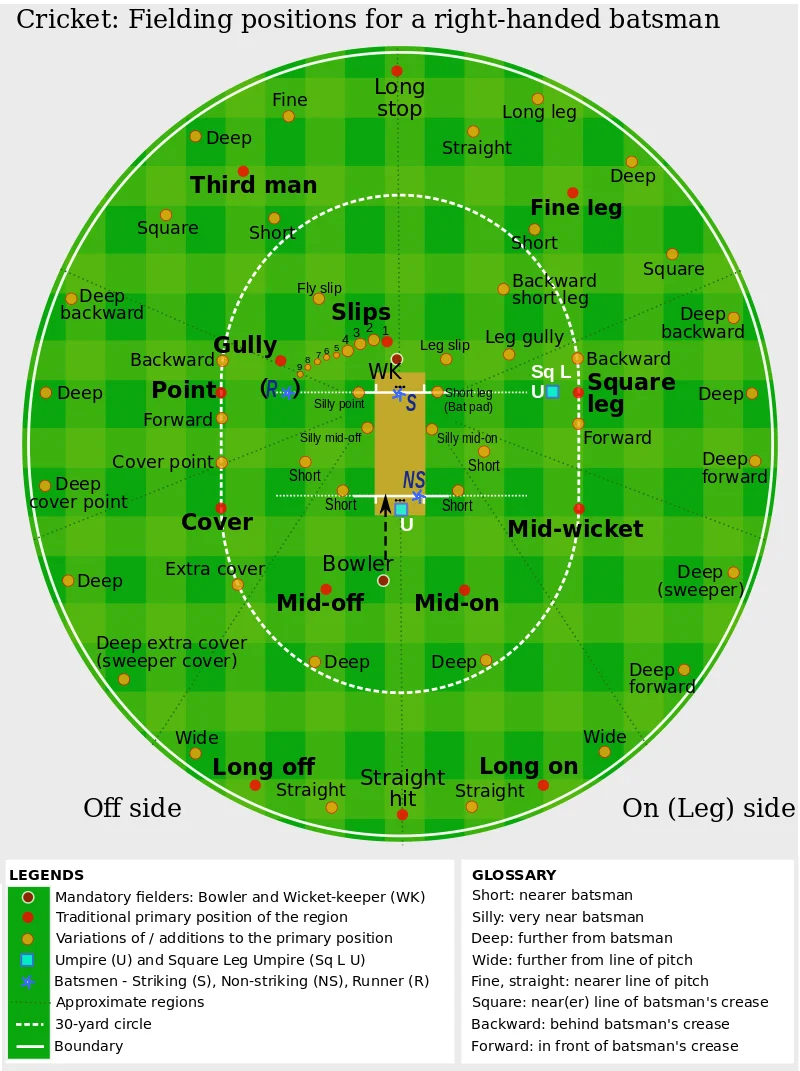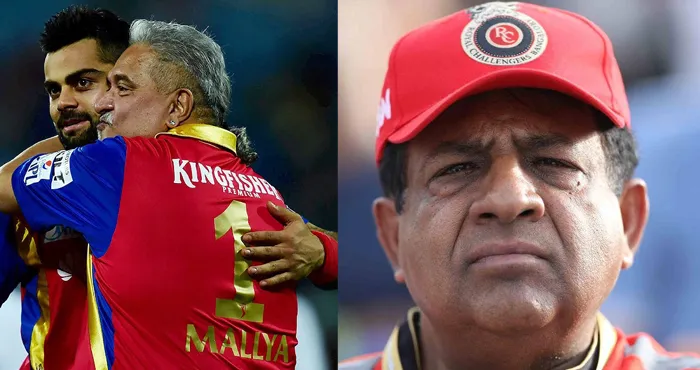Cricket Fielding Positions
Cricket is the number one sports game in India. It has gained millions of followers throughout the world. The spectacular and engaging game performance has enticed a large audience both domestically and internationally. Despite the solid teams and leading players, one aspect is highly important when playing the game or cheering up the cricket teams and placing bets on them. Along with the rules of the cricket game that are pretty simple to comprehend, fielding has become an integral part of cricket and something that confuses the followers when diving into this baffling game at the initial stages. From captain to wicket-keeper, bowler, batsman, and fielder, every cricket player takes a particular place in the field that defines his appropriate action within the game. That’s why it is essential to look through cricket fielding positions and clarify the names of cricket positions.
Cricket Fielding Positions Chart
To start with, the player’s position in the field depends on the way the batman bats the ball, i.e., whether he is right-handed or left-handed. This focus determines the next positioning of cricket players in the field. The chart below displays the cricket fielding positions for the right-handed batsman. Accordingly, the right side of the chart reflects the
Leg (On)
side field and the left side — the
Offside field. When the left-handed batsman plays the game, the cricket positions on each field side are exactly the opposite.

Before getting into the interpretation of the meaning of each fielding position, it is necessary to understand first the main players’ roles in the cricket side, which are made up of 11 players. When their side is not batting, they are automatically considered fielders.
Each team decides what number of batsmen and bowlers they want to engage. But this question should be kept in a good balance as it may influence the outcome of the cricket team in the match. Here are the basic roles in the cricket game:
- captain — the most responsible role in the side who takes decisions on who will start the game, tactics, and strategies played in the game;
- wicketkeeper — accountable for catching and returning the ball every time it is bowled;
- bowler — not less responsible than the previous ones: he is to bowl the ball so that the batsman can’t score easy runs;
- batsman — responsible for scoring the runs when it is time for them to bat!
In addition, cricket fielding positions are generally divided into three parts: a close catching infield, an inner ring, and an outfield.
The close catching
infield involves fielders placed near the batsman and are initially in place to take catches. Typically, they are at a distance of 15 yards away from the batsman. This part of the field contains such positions as Slips, Silly Point, Leg-slip, and Short-leg. The batsman can be caught in Slips when trying to play away from the body or can be declined at Silly point and Short-leg when trying to defend.
The inner ring is a 30-yard circle. Fielders within this part of fielding play a dual role:
- don’t let the ball pass through them;
- try to save runs;
- hold on to catches that come their way!
The fielder in this position should possess quick reflexes as the batsman can hit the ball aggressively enough. And the reaction time is quite limited. This fielding part includes such positions as Gully, Leg Gully, Point, Square Leg, Cover, Mid-wicket, Mid-off, and Mid-on.
An outfield is a responsible place for those fielders who are to protect the boundary regions. They are expected to have safe hands as they are also to get catches when they come their way when the batsman hits over the top. The main positions in the outfield are Long-on and Long-off.
All Fielding Positions Names and Explanation in Cricket
Cricket fielding positions are crucial and need to be allocated on the ground properly. Due to the strength, speed, catching ability, and other factors, each team player takes their respective positions in the field. The prominent cricket roles and a big part of the cricket field are mentioned above. And now let’s have a look at each name of cricket positions and explain them.
- Wicket-Keeper
This position is regarded as one of the most responsible in cricket fielding positions. The wicket-keeper’s position is behind the batsman, and he is to catch the ball when the batsman misses or leaves it. There is a particular distance between the batman and wicket-keeper. It depends on the speed of the bowler who throws the ball to the batsman. If a professional bowler plays, it is possible to see how the wicket-keeper takes his position about 20 meters away from the batsman. If it is a less experienced bowler, for example, spinner, then the distance between the wicket-keeper and batsman is shorter and closer to the stumps. Thus, the wicket-keeper’s place towards the batsman differs from the type of bowler engaged in the game performance.
To become a good wicket-keeper, one should be fit, have a high level of agility and eye-hand coordination. According to the fact that bowlers are not always accurate in throwing the ball, wicket-keepers need to dive around in order to catch the ball. Another thing they are responsible for is catching incoming throwings from other fielders. The closer they stand behind the batsman, the fewer mistakes they can make.
The wicket-keeper usually wears gloves and a helmet in case when he stands very close to the stumps to protect himself.
- Slips
Slips take the position next to the wicket-keeper. There are four fielding positions within the slips: 1st slip, 2nd slip, 3rd slip, and 4th slip. They are to catch the ball when the batsman edges it between them. Slip fielders should be of great concentration for a long period. That is because the ball hit can be in a different direction. So, when the chance comes, they need to react quickly and catch the ball.
The captain and the bowler define the number of fielders in the slip. The captain’s decision can be explained by the way the bowler bowls. If he bowls the ball and it is swinging in the air, it is possible to watch 3 slip positions on the field. When there is less movement in the air, and the batsman is dominating the bowler, the captain has the right to remove all the slip fielders and put them in another position. In the spinner bowling case, it is obvious to see more than one split fielder in the game.
- Third Man
The position of the third man lies on the boundary of the offside of the field. This fielding position is frequently used when the slips are not used. Such an approach is more suitable for test matches. Otherwise, in limited-overs matches and longer formats of cricket slips are more prevalent in use than the third man.
- Gully
The gully position is very close to one of the slip fielders taking the diagonal stand. This position shows up in several scenarios when:
- the ball is swinging around at the beginning of the match;
- the wicket has been taken, and a new batman player is engaged;
- playing on the “slow pitch”;
- the captain feels like an edge is likely to move to the direction of the gully rather than the slips;
- in the history of a batsman, he was caught in the gully region!
The abilities of fielders in the gully position should be the same as required for those who field slips.
- Point
The point position is on the inner ring field on the offside is taken by the fielder. The distance again between the point fielder and the batsman differs from the type of the bowler who operates. However strong the bowler is, the captain is the one who takes a decision on how far or close the point fielder needs to stand towards the batsman.
Due to the fact that most bowlers are focused on bowling the off stump of the batsman, the further action taken by the batsman is quite attacking. This leads to the probable ball’s direction to the point position. That’s why the cricket team prefers to put at the point the best athletic fielders to handle the task. Accordingly, he needs to cover much ground both to the right and left in order to catch the ball and not let it pass through their line.
- Cover
The cover position is found on the inner circle between the point and the extra cover. It is also an important position as the cover fielder has opportunities for run-outs and stops the boundary by jumping to the right and left.
Some captains prefer not to use this cover position. Its absence in the field enables the batsman to drive the ball. Sometimes it is worth it for the team; sometimes it is not. By choosing this alternative, the captain hopes that the bowler will beat the batsman early and will direct the ball to the wicket-keeper or slips.
- Mid Off
The task of players at mid off is to stop the batsman who hits the ball towards the long off boundary. As the practice shows, many shots go through this area. That’s why the captain of each cricket team should be confident that he puts at mid off a well-fitted fielder able to cover any shot quickly and ready for frequent diving around.
Also, captains often prefer to locate themselves at mid off because they can have straightforward communication with the bowler as well as coordinate the fielders around the bat.
- Long Off
The long off refers to the outfield position. It is considered a frequently shotted area by batsmen. If the bowler does his work at full, then there is a high probability that most shots will end up in this position. It is also an area where the batsman will play an aerial shot, especially against the spin bowler. Like any other boundary fielder mentioned above, the main task is to catch the shots and cut off the boundaries.
- Long On
The long on position is regarded as the final cricket fielding position on the batsman’s (leg) side. It is quite a strong position: long on fielders are chosen to be a run-saving option or a constraining factor for batsmen who are willing to hit sixes straight down the ground. The fielder in this position needs to be in good shape to cover much ground to cut off any shots.
-
Mid-On
Basically, it is the same position as mid off but on the opposite part of the cricket field that is leg (on) side. The role of the mid-on fielder is equal to the mid off: to block any shots directed towards this area and cover the gap between themselves and mid-wicket. It is also considered a good position for captains to locate themselves there.
-
Mid-Wicket
The responsibility in this position is extremely high as batsmen make many powerful shots towards the mid-wicket area. The fielder there needs to be very athletic and able to cut off the boundary shots.
-
Square Leg
This position is easily found thanks to the referee’s location that is in the square leg side. The fielder in the square leg will need to cope with multitasking: to stop the single if the batsman wants to knock the ball, dive around when the batsman plays the hook / pull shots to fast bowlers sweep to a spinner.
The captain should think about locating one of the best fielders in the square leg position compared to the point position. He has to cover much ground on the leg side, especially when there is no mid-wicket or fine leg fielder around.
-
Fine Leg
This crucial position is chosen in order to stop two things when:
- the batsman plays the sweep shot to a spinner;
- the batsman hits the ball off behind the square on the leg side while a fast bowler is bowling!
The fine leg fielding position requires a cricket player with a quick reaction, the ability to quickly gather balls and throw them back to wicket-keepers, be fit to conquer a lot of runs.
Due to all positions mentioned, the squad team needs to be well athletic to throw the ball and hit it with a wicket and be resilient and fast in catching the ball on the field boundaries, diving around on the right and left sides. All these actions make the game itself unexpected and unpredictable somewhere. That is why cricket engages more and more fans and satisfies their thrill.












